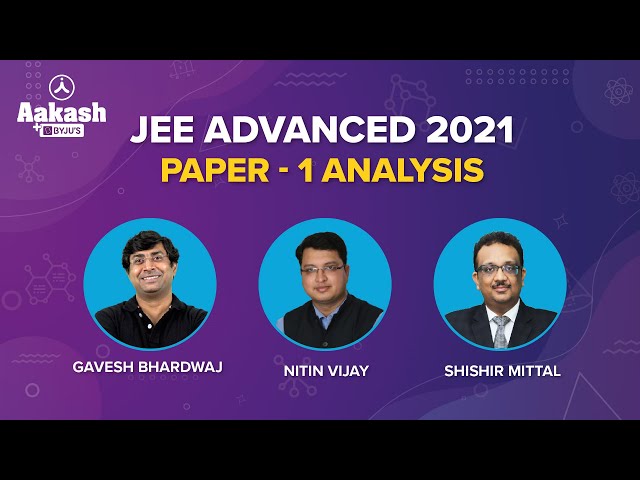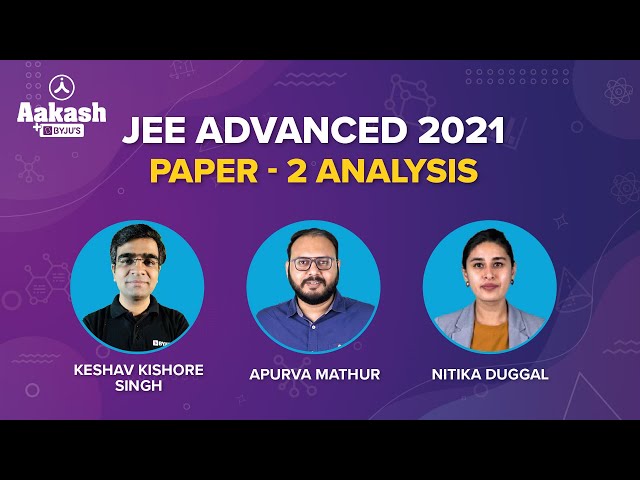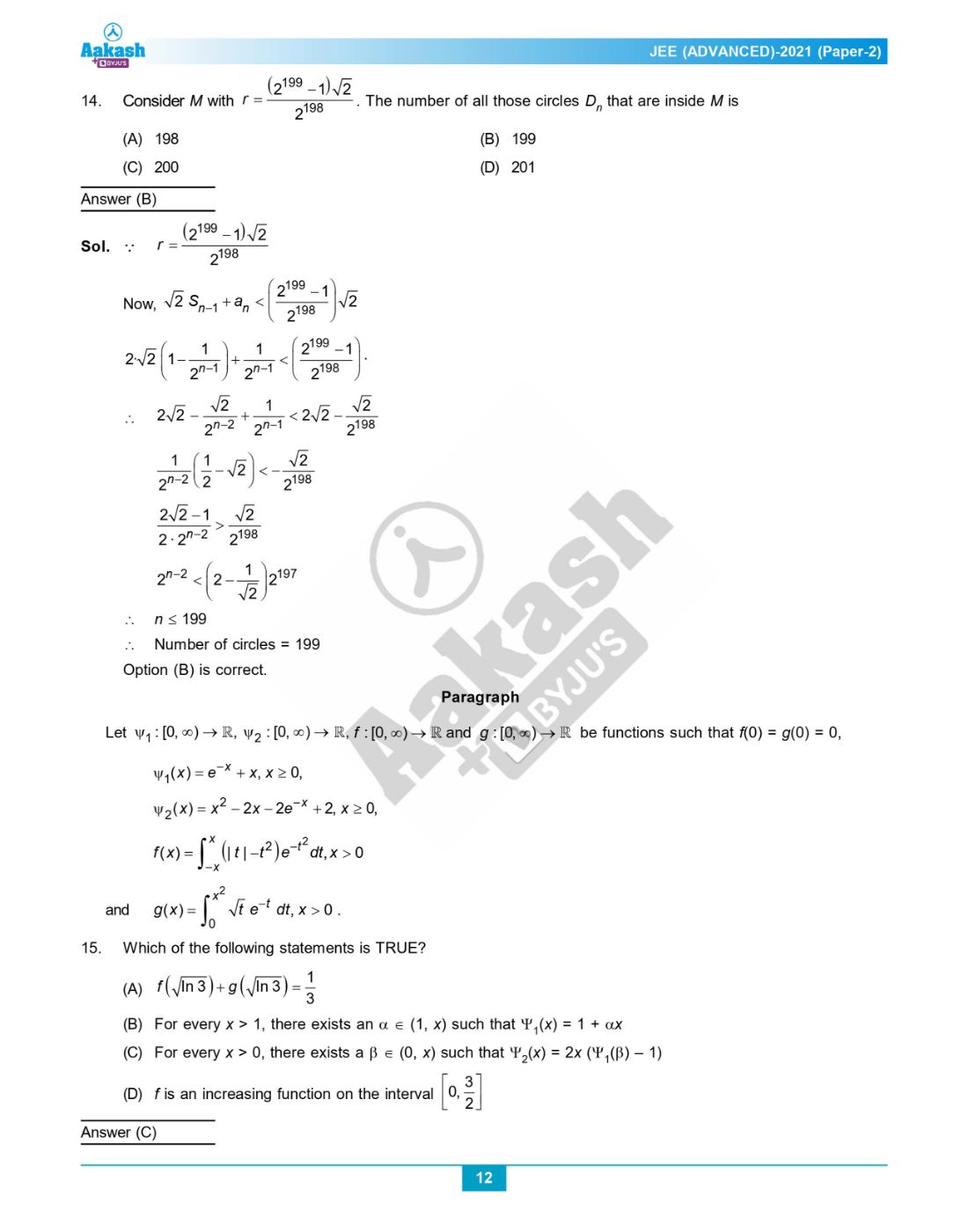Students can instantly download the solved JEE Advanced 2021 Maths question paper for Paper 2 in PDF format for offline practice. We have also provided analysis videos of both Paper 1 and Paper 2 for the exam that was held on October 3rd. Students will further get helpful insights about the paper pattern, question types, weightage of marks and more. More significantly, engaging in this study exercise will keep every JEE aspirant in good stead as the exam approaches nearer and nearer.
Question 1: Let;
S1 = {(i, j, k) : i, j, k ∈ {1,2,…,10}}
S2 = {(i, j) : 1 ≤ i < j + 2 ≤ 10,i, j ∈ {1,2,…,10}}
S3 = {(i, j, k, l) : 1 ≤ i < j < k < l, i, j, k, l ∈ {1,2,…,10}}
S4 = {(i, j,k,l ) : i, j, k and l are distinct elements in {1,2,…,10}}.
If the total number of elements in the set Sr is nr, r = 1, 2,3,4, then which of the following statements is (are) TRUE?
a. n1 = 1000
b. n2 = 44
c. n3 = 220
d. n4/12 = 420
Answer: (a, b, d)
Number of elements in S1 = 10 × 10 × 10 = 1000
Number of elements in S2 = 9 + 8 + 7 + 6 + 5 + 4 + 3 + 2 = 44
Number of elements in S3 = 10C4 = 210
Number of elements in S4 = 10P4 = 210 × 4! = 5040
Question 2: Consider a triangle PQR having sides of lengths p, q, and r opposite to the angles P, Q, and R, respectively. Then which of the following statements is (are) TRUE?
a. cos P ≥ 1 – p2/2qr
b. cos R ≥ ((q-r)/(p+q))cos P + ((p-r)/(p+q))cos Q
c. (q+r)/p < 2√(sin Q sin R)/sin P
d. if p<q and p<r, then cos Q > p/r and cos R > p/q
Answer: (a, b)

(a) cos P = (q2+r2 – p2)/2qr
And (q2+r2)/2 ≥ √(q2. r2) (AM ≥ GM)
⇒ (q2+r2) ≥ 2qr
So cos P ≥ (2qr – p2)/2qr
cos P ≥ 1 – p2/2qr
(b) ((q-r) cos P + (p-r) cos Q)/(p+q) = ((q cos P + p cos Q) – r(cos P + cos Q))/(p+q)
= r(1- cos P – cos Q)/(p+q)
= (r(q-p cos R) – (p-q cos R))/(p+q)
= ((r-p-q)+(p+q)cos R)/(p+q)
= cos R + (r-q-p)/(p+q) ≤ cos R (since r < p+q)
(c) (q+r)/p = (sin Q + sin R)/sin P ≥ 2√(sin Q sin R)/sin P
(d) If p < q and q < r
So, p is the smallest side, therefore one of Q or R can be obtuse
So, one of cos Q or cos R can be negative
Therefore, cos Q > p/r and cos R > p/q cannot hold always.
Question 3: Let f: [-π/2, π/2] → R be a continuous function such that f(0) = 1 and ∫0π/3 f(t) dt = 0. Then which of the following statements is (are) TRUE?
a. The equation f(x) – 3 cos 3x = 0 has at least one solution in (0, π/3)
b. The equation f(x) – 3 sin 3x = -6/π has at least one solution in (0, π/3)
c.
d.
Answer: (a, b, c)
f(0) = 1, ∫0π/3 f(t) dt = 0
(a) Consider a function g(x) = ∫0x f(t)dt – sin 3x. g(x) is continuous and differentiable function
And g(0) = 0
g(π/3) = 0
By Rolle’s theorem g’(x) = 0 has at least one solution in (0, π/3)
f(x) – 3 cos 3x = 0 for some x ∈ (0, π/3)
(b) Consider a function
h(x) = ∫0x f(t)dt + cos 3x + 6x/π
h(x) is continuous and differentiable function and h(0) = 1
h(π/3) = 1
By Rolle’s theorem h’(x) = 0 for at least one x ∈ (0, π/3)
f(x) – 3 sin 3x + 6/π = 0 for some x ∈ (0, π/3)
(c)
(0/0 form)
By L’Hospital rule
=
=
= (0+2f(0))/(0-2)
= -1
(d)
=
=
= (1+0+1-0)/2
= 1
Question 4: For any real numbers α and β, let yα,β(x), x ∈ R, be the solution of the differential equation dy/dx + αy = xeβx, y(1) = 1. Let S = {yα,β(x), α, β ∈ R } . Then which of the following functions belong(s) to the set S?
a. f(x) = (x2/2)e-x + (e – ½)e-x
b. f(x) = (-x2/2)e-x + (e + ½)e-x
c. f(x) = (ex/2)(x-½) + (e – e2/4)e-x
d. f(x) = (ex/2)(½ -x) + (e + e2/4)e-x
Answer: (a, c)
dy/dx + αy = xeβx
Integrating factor (I.F) = e∫αdx = eαx
So, the solution is y.eαx = ∫xeβx eαx dx
y.eαx = ∫xe(β+α)x dx
If α + β ≠ 0
yeαx = x e(α+β)x/(α+β) – e(α+β)x/(α+β)2 + C
y = [eβx/(α+β)][x – 1/(α+β)] + Ce-αx …(i)
Put α = β = 1 in (i)
y = (ex/2)(x – ½) + Ce-x
y(1) = 1
1 = (e/2)(½) +C/e
⇒ C = e – e2/4
So, y = (ex/2)(x-½) + (e – e2/4)e-x
If α + β = 0 and α = 1
dy/dx + y = xe-x
I.F = ex
yex = ∫x dx
yex = x2/2 + C
y = e-xx2/2 + Ce-x
y(1) = 1
1 = 1/2e + C/e
⇒ C = e – ½
y = e-xx2/2 + (e – ½)e-x
Question 5: Let O be the origin and
a. Projection of
b. Area of the triangle OAB is 9/2
c. Area of the triangle ABC is 9/2
d. The acute angle between the diagonals of the parallelogram with adjacent sides
Answer: (a, b, c)
=
Now,
So,
So, λ = 1 (since λ >0)
(a) Projection of vector OC on vector OA =
= ½ (-2-8+1)/3
= -3/2
(b) Area of triangle OAB =
(c) Area of the triangle ABC is =
=
= 9/2
(d) Acute angle between the diagonals of the parallelogram with adjacent sides
cos θ =
= 18/3√2 ×√90
θ ≠ π/3
Question 6: Let E denote the parabola y2 = 8x. Let P = (-2, 4), and let Q and Q’ be two distinct points on E such that the lines PQ and PQ’ are tangents to E. Let F be the focus of E. Then which of the following statements is (are) TRUE?
a. The triangle PFQ is a right-angled triangle
b. The triangle QPQ’ is a right-angled triangle
c. The distance between P and F is 5√2
d. F lies on the line joining Q and Q’
Answer: (a, b, d)
E : y2 = 8x
P : (-2, 4)

Point P (-2, 4) lies on directrix (x = -2) of parabola y2 = 8x
So, ∠QPQ’ = π/2 and chord QQ’ is a focal chord and segment PQ subtends a right angle at the focus.
Slope of QQ’ = 2/(t1+t2) = 1
Slope of PF = -1
PF = 4√2
Question Stem for Question Nos. 7 and 8
Consider the region R = {(x,y)∈ R×R : x ≥ 0 and y2 ≤ 4 – x. Let F be the family of all circles that are contained in R and have centres on the x-axis. Let C be the circle that has the largest radius among the circles in F. Let (α, β) be a point where circle C meets the curve y2 = 4 – x.
Question 7: The radius of the circle C is
Answer: (1.50)
Question 8: The value of α is
Answer: (2.00)
Sol: For comprehension Question 7 and Question 8

Let the circle be,
(x – a)2 + y2 = r2
Solving it with parabola
y2 = 4 – x we get
(x – a)2 + 4 – x = r2
x2 – x(2a + 1) + (a2 + 4 – r2) = 0 …(1)
D = 0
⇒ 4r2 + 4a – 15 = 0
Clearly a ≥ r
So 4r2 + 4r – 15 ≤ 0
⇒ rmax = 3/2 = a
Radius of circle C is 3/2
From (1) x2 – 4x + 4 = 0
⇒ x = 2 = α
Question Stem for Question Nos. 9 and 10
Let f1 : (0, ∞) → R and f2 : (0, ∞) → R be defined by f1(x) =
Question 9: The value of 2m1 + 3n1 + m1n1 is
Answer: (57.00)
Question 10: The value of 6m2 + 4n2 + 8m2n2 is
Answer: (06.00)
Solution for Question 9 and 10
f1’(x) = (x – 1)(x – 2)2 (x – 3)3 ,…, (x – 20)20 (x – 21)21
Checking the sign scheme of f1’(x) at x = 1, 2, 3, …, 21, we get
f1(x) has local minima at x = 1, 5, 9, 13, 17, 21 and local maxima at x = 3, 7, 11, 15, 19
⇒ m1 = 6, n1 = 5
f2(x) = 98(x – 1)50 – 600(x – 1)49 + 2450
f2’(x) = 98 × 50(x – 1)49– 600 × 49 × (x – 1)48
= 98 × 50 × (x – 1)48 (x – 7)
f2(x) has local minimum at x = 7 and no local maximum.
⇒ m2 = 1, n2 = 0
2m1 + 3n1 + m1n1
= 2 × 6 + 3 × 5 + 6 × 5
= 57
6m2 + 4n2 + 8m2n2
= 6 × 1 + 4 × 0 + 8 × 1 × 0
= 6
Question Stem for Question Nos. 11 and 12
Let gi = [π/8, 3π/8] → R, i = 1, 2 and f: [π/8, 3π/8] → R be the functions such that g1(x) = 1, g2(x) = |4x – π| and f(x) = sin2x, for all x∈[π/8, 3π/8]. Define
Question 11: The value of 16S1/π is
Answer: (2.00)
S1 = ∫π/83π/8 sin2x . 1 dx
= ½ ∫π/83π/8(1 – cos 2x)dx
= ½ (x – sin 2x/x)π/83π/8
= ½ (π/4 – 0)
= π/8
=> 16S1/π = 2
Question 12:The value of 48S2/π2 is
Answer: (1.50)
S2= ∫π/83π/8 sin2x |4x – π| dx
= ∫π/83π/8 4 sin2x |x – π/4| dx
Let x – π/4 = t
=> dx = dt
S2 = ∫-π/8π/8 4 sin2 (π/4 + t)|t| dt
= ∫-π/8π/8 2(1 – cos 2(π/4 + t) |t| dt
= ∫-π/8π/8 (2 + 2 sin 2t) |t| dt
= 2∫-π/8π/8|t|dt + 2∫-π/8π/8|t| sin 2t dt
= 4∫0π/8t dt + 0
S2 = [2t2]0π/8
= π2/32
48S2/π2 = 3/2
Question Paragraph: Let M = {(x, y) ∈ R × R : x2 + y2≤ r2}, where r > 0. Consider the geometric progression an = 1/2n-1, n = 1,2, 3… Let S0 = 0 and, for n ≥ 1, let Sn denote the sum of the first n terms of this progression. For n ≥ 1 , let Cn denote the circle with center (Sn–1, 0) and radius an, and Dn denote the circle with center (Sn–1, Sn–1) and radius an.
Question 13: Consider M with r = 1025/513. Let k be the number of all those circles Cn that are inside M. Let l be the maximum possible number of circles among these k circles such that no two circles intersect. Then,
a. k + 2l = 22
b. 2k + l = 26
c. 2k + 3l = 34
d. 3k + 2l = 40
Answer: (d)
an = 1/2n-1
And Sn = 2(1 – 1/2n)
For circles Cn to be inside M.
Sn-1 + an < 1025/513
⇒ Sn < 1025/513
⇒ 1 – 1/2n < 1025/1026
⇒ 1 – 1/1026
⇒ 2n < 1026
⇒ n ≤ 10
∴ Number of circles inside be 10 = K
Clearly, alternate circles do not intersect each other i.e., C1, C3, C5, C7, C9 do not intersect each other as well as C2, C4, C6, C8 and C10 do not intersect each other hence maximum of 5 set of circles do not intersect each other.
∴ l = 5
∴ 3K + 2l = 40
∴ Option (D) is correct
Question 14: Consider M with r = (2199-1)√2/2198. The number of all those circles Dn that are inside M is;
a. 198
b. 199
c. 200
d. 201
Answer: (B)
Since r = (2199-1)√2/2198
Now, √2Sn-1 + an < (2199-1)√2/2198
2√2(1 – 1/2n-1) + 1/2n-1 < (2199-1)/2198
∴ 2√2 – √2/2n-2 + 1/2n-1 < 2√2 – √2/2198
(1/2n-2)(½ – √2) < -√2/2198
(2√2-1)/2. 2n-2 > √2/2198
2n-2 < (2 – 1/√2) 2197
n ≤ 199
∴ Number of circles = 199
Option (B) is correct.
Question Paragraph: Let ψ1 = [0, ∞) → R, ψ2 = [0, ∞) → R, f:[0, ∞) → R and g:[0, ∞) → R be functions such that f(0) = g(0) = 0,
ψ1(x) = e-x + x, x≥0,
ψ2(x) = x2 – 2x – 2e-x + 2, x≥0
And
Question 15: Which of the following statements is TRUE?
a. f(√ln 3) + g(√ln 3) = ⅓
b. For every x > 1, there exists an α ∈ (1, x) such that ψ1(x) = 1 + α x
c. For every x > 0, there exists a β ∈ (0, x) such that ψ2(x) = 2x (ψ1(β) -1)
d. f is an increasing function on the interval [0, 3/2]
Answer: (c)
Since,
Let t = u2
⇒ dt = 2u du
So g(x) =
=
And
Therefore
From equation (i) + (ii) : f(x) + g(x) =
Let t2 = P
⇒ 2t dt = dP
f(x) + g(x) =
f(x) + g(x) =
∴ f(√ln 3) + g(√ln 3) = 1-e-ln 3
= 1-⅓
= ⅔
∴ Option (a) is incorrect.
From equation (ii) : f’(x) =
Since f(x) is increasing in (0, 1)
∴ Option (d) is incorrect
ψ1(x) = e-x + x
⇒ ψ1’(x) = 1- e-x <1 for x>1
Then for α ∈ (1, x), ψ1(x) = 1+ αx does not true for α > 1.
∴ Option (b) is incorrect
Now ψ2(x) = x2 – 2x – 2e-x + 2
ψ2’(x) = 2x – 2 + 2e-x
∴ ψ2’(x) = 2ψ1(x)-2
From LMVT
[ψ2(x) – ψ2(0)]/(x-0) = ψ2’(β) for β ∈(∞, x)=> ψ2(x) = 2x(ψ1(β) – 1)
Option (c) is correct.
Question 16: Which of the following statements is TRUE?
a. ψ1(x) ≤ 1, for all x>0
b. ψ2(x) ≤ 0, for all x>0
c.
d. g(x)≤ (2/3) x3 – (⅖)x5 + (1/7)x7, for all x∈(0, ½)
Answer: (d)
Since ψ1(x) = e-x+x
And for all x>0, ψ1(x) > 1
∴ (a) is not correct
ψ2(x) = x2 + 2 – 2(e-x + x) >0 for x > 0
∴ (b) is not correct.
Now, √te-t = √t(1 – t/1! + t2/2! – t3/3! + ….∞)
And √te-t ≤ t1/2 – t3/2 + ½ t5/2
∴
= (⅔) x3 – (⅔) x5 + (1/7) + (1/7) x7
∴ Option (d) is correct
And
=
=
=
Therefore
=
∴ Option (c) is incorrect.
Question 17: A number is chosen at random from the set {1, 2, 3……, 2000}. Let p be the probability that the number is a multiple of 3 or a multiple of 7. Then the value of 500p is;
Answer: (214)
E = a number which is multiple of 3 or multiple of 7
n(E) = (3, 6, 9, …….., 1998) + (7, 14, 21, ……….., 1995) – (21, 42, 63, ……… 1995)
n(E) = 666+ 285 – 95
n(E) = 856
n(E) = 2000
P(E) = 856/2000
P(E) × 500 = 856/4 = 214
Question 18: Let E be the ellipse x2/16 + y2/9 = 1. For any three distinct points P, Q and Q’ on E, let M (P, Q) be the mid-point of the line segment joining P and Q, and M(P, Q’) be the mid-point of the line segment joining P and Q’. Then the maximum possible value of the distance between M (P, Q) and M(P, Q’), as P, Q and Q’ vary on E, is
Answer: (4)
Let P(α), Q(θ), Q’(θ’)
M = ½ (4 cos α + 4 cos θ), ½ (3 sin α + 3 sin θ)
M’ = ½ (4 cos α + 4 cos θ’), ½ (3 sin α + 3 sin θ’)
MM’ = ½ √((4 cos θ – 4 cos θ’)2 + (3 sin θ – 3 sin θ’)2)
MM’ = ½ distance between Q and Q’
MM’ is not depending on P
Maximum of QQ’ is possible when QQ’ = major axis
QQ’ = 2(4) = 8
MM’ = ½ (QQ’)
MM’ = 4
Question 19: For any real number x, let [x] denote the largest integer less than or equal to x. If
Answer: (182.00)
y = 10x/(x+1), 0 ≤ x≤10
xy+y = 10x
x = y/(10-y)
0≤ y/(10-y) ≤ 10
y/(10-y) ≥ 0 and (y/(10-y)) – 10 ≤ 0
y/(y-10) ≤ 0 and (11y-100)/(y-10) ≥ 0

y ∈ [0, 10) and y ∈ (-∞, 100/11] ⋃ (10, ∞)
y ∈ [0, 100/11]
√y ∈ [0, 10/√11]
⇒ [√y] = {0, 1, 2, 3}
Case 1:
0≤10x/(x+1) < 1
10x/(x+1) ≥ 0 and 10x/(x+1) – 1 < 0

x∈ (-∞, -1) ⋃ [0, ∞) and x∈ (-1, 1/9)
x∈ [0, 1/9) then [√(10x/(x+1))] = 0
Case 2:
1 ≤ 10x/(x+1) < 4
10x/(x+1) – 1 ≥ 0 and 10x/(x+1) – 4 < 0
(9x-1)/(x+1) ≥ 0 and (6x-4)/(x+1) < 0

x∈ (-∞, -1)⋃ [1/9, ∞) and x∈ (-1, ⅔)
x∈[1/9, ⅔), [√(10x/(x+1))] = 1
Case 3:
4 ≤ (10x/x+1) < 9
10x/(x+1) – 4 ≥ 0 and 10x/(x+1) < 9
(6x-4)/(x+1) ≥ 0 and (x-9)/(x+1) < 0

x∈ (-∞, -1)⋃ [2/3, ∞) and x∈ (-1, 9)
x∈ [⅔, 9); [√(10x/(x+1))] = 2
Case 4:
x∈ [9, 10]
⇒ [√(10x/(x+1))] = 3
l =
l = (⅔ – 1/9) +2(9-⅔) + 3(10-9)
l = 5/9 + 50/3 + 3
9l = 182




















Comments